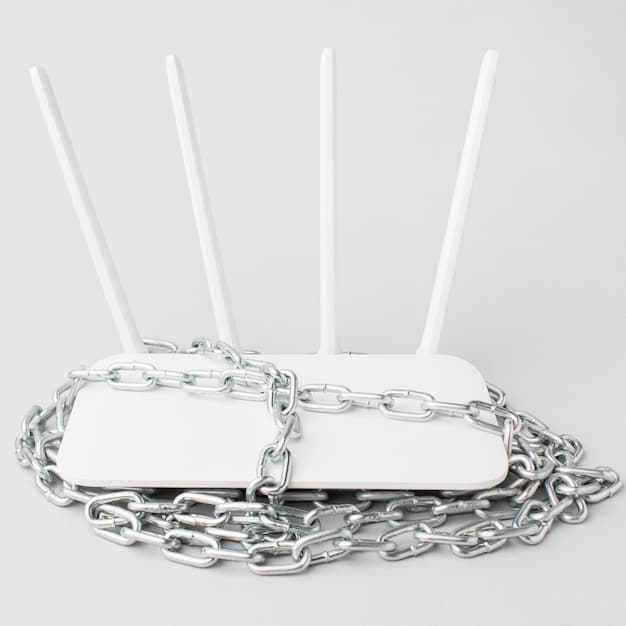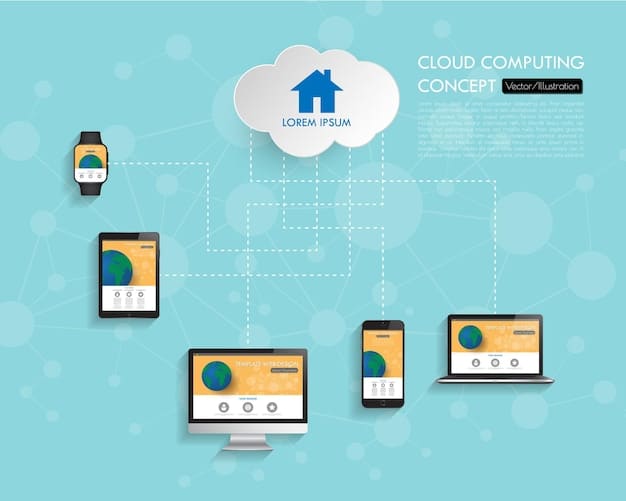Is Your Smart Home Secure? 7 Tips for 2025

Ensuring your smart home is secure involves proactive measures such as strong passwords, regular software updates, securing your Wi-Fi network, enabling multi-factor authentication, monitoring device activity, using a separate network for IoT devices, and staying informed about the latest security threats.
As we integrate more devices into our homes, the question, is your smart home secure? becomes increasingly critical. Protecting your connected devices from cyber threats requires more than just a password; it demands a comprehensive approach to cybersecurity.
Understanding the Smart Home Security Landscape
The rise of smart homes has brought unparalleled convenience, but it has also opened new doors for cybercriminals. Each connected device represents a potential entry point into your network. Understanding the risks is the first step in securing your digital domain.
Common Security Vulnerabilities in Smart Homes
Many smart home devices ship with default passwords, weak encryption, or outdated software, making them easy targets for hackers. It’s crucial to identify and address these vulnerabilities to protect your home network.
- Unsecured Wi-Fi networks
- Default or weak passwords
- Outdated device firmware
- Lack of encryption
Taking the time to understand where your vulnerabilities lie will greatly assist in improving your overall security.
Securing Your Wi-Fi Network: The Foundation of Smart Home Security
Your Wi-Fi network is the central hub of your smart home. Securing it is paramount. A compromised Wi-Fi network gives attackers access to all connected devices, making it essential to implement robust security measures.

Strengthening Your Wi-Fi Password
Using a strong, unique password is the most fundamental step in securing your Wi-Fi network. Avoid easily guessable passwords like “password” or “123456.”
Implementing these safeguards on your Wi-Fi network is a foundational aspect of securing your overall smart home network.
Enabling Multi-Factor Authentication (MFA) for Enhanced Protection
Multi-factor authentication (MFA) adds an extra layer of security to your accounts. Requiring a second form of verification makes it significantly harder for attackers to gain unauthorized access, even if they have your password.
How MFA Works
MFA typically involves something you know (your password) and something you have (a code sent to your phone or a biometric scan). This dual-layer approach drastically reduces the risk of account compromise.
- Adds an extra layer of security verification
- Reduces the risk of unauthorized access to critical accounts
- Provides a more secure login process.
Regularly Updating Your Smart Device Software and Firmware
Software updates often include critical security patches that address newly discovered vulnerabilities. Keeping your devices up to date is essential to protect against known exploits.
Often, the prompt for software updates are ignored given the frequency in which they appear. However, it’s important to take the time to update your device when you receive a notification.
Creating a Separate Network for IoT Devices
Segmenting your network by creating a separate network for your smart devices can limit the damage from a potential security breach. This means isolating your more vulnerable devices from your more secure computers and personal devices.
Benefits of Network Segmentation
By isolating your IoT devices, you prevent attackers from using them as a springboard to access more sensitive data on your primary network. This strategy enhances your overall security posture.

Monitoring Device Activity and Network Traffic
Regularly monitoring your device activity and network traffic can help you detect suspicious behavior early. Keep an eye out for unusual data usage, unfamiliar devices on your network, or unauthorized access attempts.
- Monitor device activity for suspicious behavior
- Regularly check network traffic for anomalies
- Set up alerts for unauthorized access attempts.
Being proactive and vigilant is key to staying on top of any potential threats.
Staying Informed About Emerging Threats and Best Practices
The cybersecurity landscape is constantly evolving, so staying informed about the latest threats and best practices is crucial. Follow security blogs, attend webinars, and subscribe to security alerts to stay ahead of the curve.
Resources for Staying Updated
Numerous online resources offer valuable information about smart home security. Taking the time to educate yourself can help you make informed decisions and protect your home from emerging threats.
Staying informed is an ongoing process, but one that can significantly bolster your cybersecurity efforts.
| Key Point | Brief Description |
|---|---|
| 🔑 Strong Passwords | Use unique and complex passwords for all devices. |
| 🛡️ MFA | Enable multi-factor authentication for extra security. |
| 🔄 Updates | Keep software and firmware updated regularly. |
| 🌐 Separate Network | Create a separate network for IoT devices. |
Frequently Asked Questions
▼
Smart home security is crucial because unsecured devices can expose personal data, enable unauthorized access, and compromise your entire network. Protecting your devices protects your privacy and security.
▼
A strong password should be long (at least 12 characters), unique, and include a mix of uppercase and lowercase letters, numbers, and symbols. Avoid using personal information or common words.
▼
Multi-factor authentication (MFA) adds an extra layer of security by requiring a second form of verification, like a code sent to your phone, in addition to your password, making it harder for attackers to access your accounts.
▼
You should update your devices as soon as updates are available. Security updates patch vulnerabilities that attackers can exploit, so timely updates are critical for maintaining your security.
▼
If you suspect a breach, immediately change your passwords, disconnect affected devices from the network, and contact a security professional. Monitor your accounts for suspicious activity.
Conclusion
Securing your smart home is an ongoing process that requires vigilance and proactive measures. By implementing these essential tips, you can significantly reduce your risk and enjoy the benefits of a connected home with greater peace of mind. Stay informed, stay updated, and stay secure.





